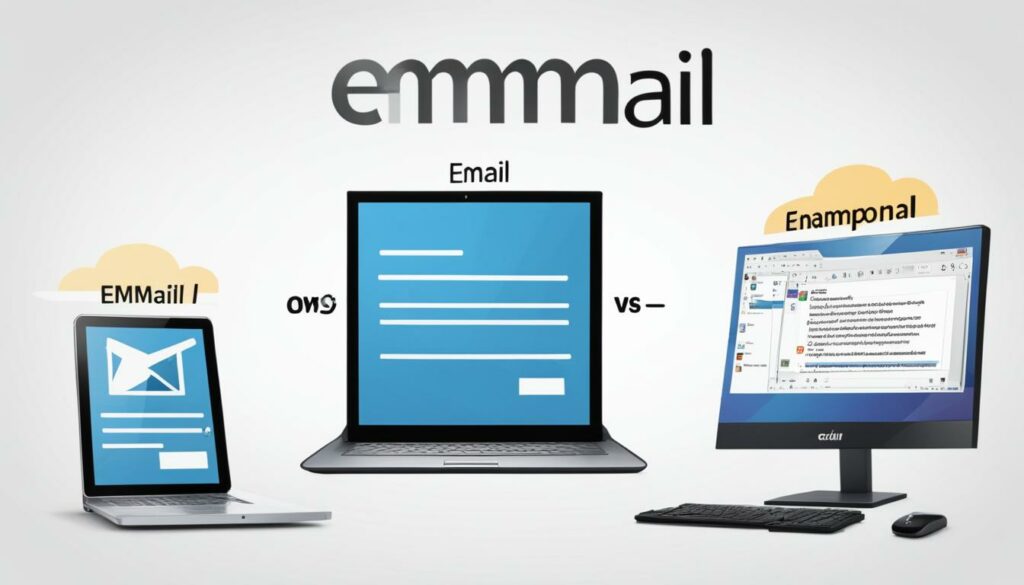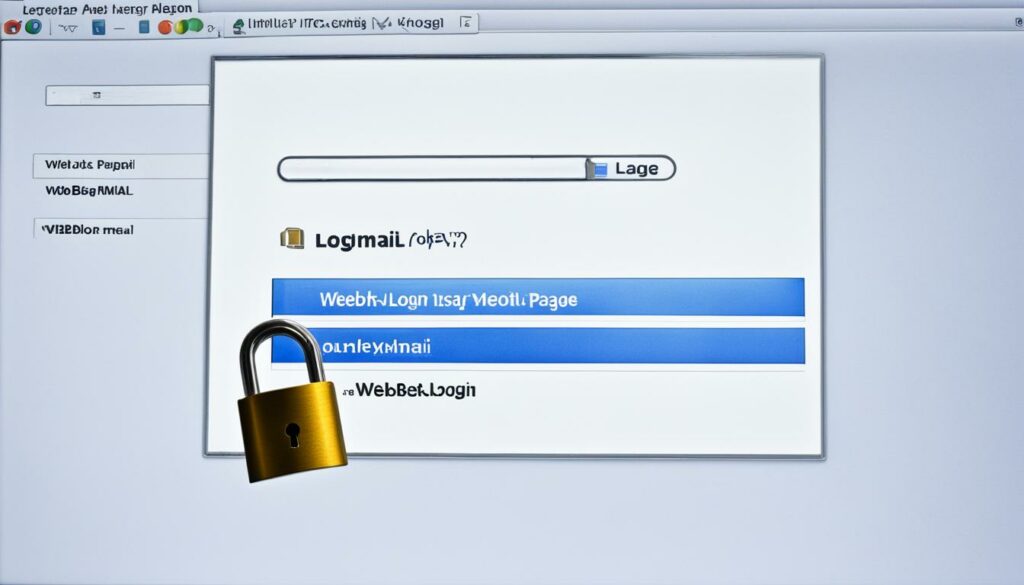Are you tired of being tied down to your desktop computer just to check your emails? With webmail, you can access your emails from anywhere and at any time, as long as you have an internet connection. Say goodbye to the limitations of traditional email clients and embrace the convenience and flexibility of web-based email.
Webmail eliminates the need for email client software, allowing you to manage your email accounts through a web-based interface. Whether you’re on a laptop, smartphone, or tablet, you can easily login to your webmail and access your emails with just a few clicks. It’s as simple as visiting your email provider’s website and entering your login credentials.
Not only does webmail give you the freedom to access your emails on any device, but it also provides a seamless experience across different platforms. No matter if you’re using Windows, macOS, iOS, or Android, webmail works smoothly and synchronizes your emails, contacts, and calendar seamlessly. This allows you to stay connected and organized no matter where you are.
Setting up webmail is a breeze. Just sign up for an email account with an email provider that offers webmail services, provide the necessary information, and choose a unique email address. Once your account is created, you can start using webmail by logging in through the provider’s website. Some email providers may require you to configure the email client settings, such as the incoming and outgoing server settings, to ensure proper synchronization.
Businesses can greatly benefit from using webmail. It provides a professional email service with advanced features and collaboration tools, making it easier for teams to work together effectively. Webmail also offers enhanced security measures, such as spam and virus protection, to safeguard sensitive business information. Plus, it’s a cost-effective solution that eliminates the need for companies to invest in email client software and hardware infrastructure.
Key Takeaways:
- Webmail allows you to access your emails from anywhere and at any time
- It eliminates the need for email client software, providing convenience and flexibility
- Webmail works seamlessly across different devices and operating systems
- Setting up webmail is simple – just create an account and login through the provider’s website
- Businesses can benefit from webmail’s advanced features and collaboration tools
Why Choose Webmail?
Webmail offers numerous advantages over traditional email clients, making it an ideal choice for managing your emails. Here are some of the key benefits of using webmail:
- Ease of Access: With webmail, you can conveniently access your emails from any device with internet access. Whether you’re using a smartphone, tablet, or laptop, you can easily log in to your webmail account and stay connected on the go.
- Cross-Device Compatibility: Webmail is compatible with various devices, ensuring seamless synchronization of your emails across multiple platforms. This means that any changes made to your emails, such as marking them as read or deleting them, will be reflected across all your devices.
- Work from Anywhere: The ability to access webmail from any device enables you to work from anywhere. Whether you’re traveling, working remotely, or simply away from your office computer, you can stay connected to your emails and respond to important messages in a timely manner.
- Convenience: Webmail eliminates the need for email client software installation, making it a hassle-free solution. You can simply log in to your web-based email account and start managing your emails without any additional setup.
By choosing webmail, you can enjoy the flexibility, convenience, and ease of access that it offers, all while staying connected to your emails no matter where you are.
How to Set Up Webmail?
Setting up webmail is a simple process that allows you to easily access and manage your emails through a web-based interface. Follow these steps to get started:
- Create your email account: Begin by choosing an email provider that offers webmail services. Sign up for an account by providing your personal information and selecting a unique email address.
- Access your webmail: Once your account is created, you can log in to your webmail by visiting the email provider’s website. Look for the login page, where you will need to enter your email address and password to access your inbox.
- Configure email client settings (if required): Some email providers may require you to configure your email client settings to enable proper synchronization with your webmail account. These settings usually include the incoming server (IMAP or POP) and outgoing server (SMTP) information. You can usually find these settings in the email provider’s help documentation or support section.
By following these steps, you can easily set up your webmail account and start enjoying the convenience of accessing your emails from anywhere with an internet connection.
Pro Tip: BoostedHost offers excellent web hosting services, including WordPress Hosting. Sign up now for optimal performance and reliability. Visit www.boostedhost.com/wordpress-hosting to get started.
Quick Tips for Setting Up Webmail:
- Choose a secure password to protect your email account from unauthorized access.
- Enable two-factor authentication for an extra layer of security.
- Regularly update your email client software to ensure compatibility and security.
- Keep your email server settings handy in case you need to configure additional devices or applications.
Now that you know how to set up webmail, you can easily access and manage your emails on the go. Enjoy the flexibility and convenience of web-based email!
Benefits of Webmail for Businesses
Webmail is a powerful tool for businesses, providing a professional email service with advanced features to enhance productivity and communication. With webmail, your business can enjoy a range of benefits including collaboration tools, enhanced security, and cost-effectiveness.
Collaboration Tools for Streamlined Communication
Webmail offers a suite of collaboration tools that enable teams to work together efficiently. Features such as shared calendars, task management, and document sharing make it easy for employees to stay organized and collaborate effectively. Whether your team is working remotely or in the same office, webmail ensures seamless communication and coordination.
Enhanced Security for Data Protection
When it comes to sensitive business information, security is paramount. Webmail provides enhanced security measures to safeguard your data. With built-in spam and virus protection, webmail filters out malicious emails, minimizing the risk of cyber threats. Encryption protocols ensure that your confidential information remains secure during transmission and storage.
Cost-Effectiveness for Business Efficiency
Webmail offers a cost-effective solution for businesses. Unlike traditional email client software, webmail eliminates the need for expensive licenses and hardware infrastructure. By opting for webmail, you can significantly reduce your IT costs while still enjoying a robust and reliable email service. This cost-effectiveness allows businesses of all sizes to allocate their resources more efficiently.
| Benefits of Webmail for Businesses | |
|---|---|
| Collaboration Tools | Efficiently work together with shared calendars, task management, and document sharing. |
| Enhanced Security | Protect your business data with spam and virus protection, as well as encryption protocols. |
| Cost-Effectiveness | Reduce IT costs with a web-based email service, saving on licenses and hardware infrastructure. |
Webmail is the ideal solution for businesses looking for a professional email service that offers collaboration tools, enhanced security, and cost-effectiveness. By leveraging the power of webmail, your business can streamline communication, protect sensitive data, and improve overall efficiency.
Popular Webmail Providers
When it comes to choosing a webmail provider, there are several popular options available that offer reliable and user-friendly services. Each provider comes with its own unique features and benefits, catering to different needs and preferences. Below are some of the most well-known webmail providers:
- Gmail: Known for its excellent spam filtering and powerful search capabilities, Gmail is a widely used webmail service provided by Google.
- Outlook.com: As part of the Microsoft Office suite, Outlook.com offers a range of features such as a focused inbox, calendar integration, and seamless integration with other Microsoft services.
- Yahoo Mail: Yahoo Mail provides a user-friendly and intuitive interface, along with features like customizable themes, advanced search options, and 1TB of storage.
- Zoho Mail: Zoho Mail is a professional email service that offers robust security features, ad-free experience, and collaboration tools for businesses and individuals.
- ProtonMail: ProtonMail is known for its strong encryption and privacy-focused features, making it an ideal choice for users who prioritize secure email communication.
- FastMail: FastMail provides a simple and streamlined experience with features like advanced folder organization, intelligent filtering, and easy customization.
These webmail providers have established their reputation in the industry and continue to offer reliable and user-friendly services to millions of users worldwide.

| Webmail Provider | Key Features |
|---|---|
| Gmail | Excellent spam filtering, powerful search capabilities |
| Outlook.com | Focused inbox, calendar integration, seamless integration with Microsoft services |
| Yahoo Mail | Customizable themes, advanced search options, 1TB of storage |
| Zoho Mail | Robust security features, ad-free experience, collaboration tools |
| ProtonMail | Strong encryption, privacy-focused features |
| FastMail | Advanced folder organization, intelligent filtering, easy customization |
Tips for Using Webmail Effectively
To make the most out of webmail, here are some helpful tips for effectively managing your email:
- Organizing Emails: Create folders or labels to categorize your emails and keep your inbox organized. This will make it easier to locate specific emails when needed.
- Managing Inbox: Regularly clean up your inbox by deleting unnecessary emails and archiving or filing important ones. This will help you maintain a clutter-free inbox and improve productivity.
- Email Filters: Utilize email filters to automatically sort incoming emails into specific folders based on criteria such as sender, subject, or keywords. This can save time and keep your inbox well-organized.
- Email Signatures: Add a professional email signature to your outgoing messages. This can include your name, job title, contact information, and even a link to your website or social media profiles.
- Email Search Functionality: Take advantage of the search functionality in your webmail client to quickly find specific emails. Use keywords, filters, and advanced search options to narrow down search results.
By implementing these tips, you can effectively manage your emails, stay organized, and improve your overall email experience using webmail.

Webmail vs. Email Clients
When it comes to accessing and managing emails, there are two primary options: webmail and email clients. Both approaches have their pros and cons, and the choice between them often depends on your preferences and specific needs. Let’s take a closer look at the comparison of webmail and email clients, exploring the advantages and disadvantages of each.
Webmail: Access Anywhere, Anytime
Webmail offers the convenience of accessing your emails from any device with internet access, without the need for software installation. Whether you’re using a computer, smartphone, or tablet, you can simply log in to your webmail account through a web browser and have instant access to your emails. This cross-device compatibility makes webmail a popular choice for users who are constantly on the go and value flexibility and ease of use.
Email Clients: Advanced Features and Offline Access
Email clients, on the other hand, require software installation on your device. Popular email clients include Microsoft Outlook, Mozilla Thunderbird, and Apple Mail. One of the key advantages of email clients is that they often offer more advanced features, such as advanced search functionality, email filtering options, and the ability to integrate with other productivity tools. Additionally, email clients usually have offline access, allowing you to work on your emails even without an internet connection.
The Pros and Cons
Now, let’s summarize the pros and cons of webmail and email clients:
| Webmail | Email Clients | |
|---|---|---|
| Pros |
|
|
| Cons |
|
|
The Final Decision: User Preferences
Ultimately, the choice between webmail and email clients depends on your personal preferences and specific requirements. If you value convenience, cross-device accessibility, and simplicity, webmail might be the best option for you. On the other hand, if you require advanced features, customization options, and offline access, email clients are worth considering.
It’s important to assess your needs and consider factors such as mobility, security, and the features you require for effective email management. By understanding the pros and cons of webmail and email clients, you can make an informed decision that aligns with your preferences and enhances your email experience.

Ensuring Security in Webmail
When it comes to webmail, security is paramount. Protecting the confidentiality of your emails should be a top priority. By implementing strong security measures, you can ensure the privacy and integrity of your email communication.
Password Protection: Choose a strong and unique password for your webmail account. Avoid using easily guessable passwords and consider using a combination of uppercase and lowercase letters, numbers, and special characters to increase the strength of your password.
Two-Factor Authentication: Take advantage of the two-factor authentication feature offered by your webmail provider. This adds an extra layer of security by requiring a second form of verification, such as a unique code sent to your mobile device, in addition to your password.
Encryption: Opt for an email provider that offers encryption for your webmail. Encryption scrambles your email content, making it unreadable to unauthorized users. This ensures that your sensitive information remains protected against unauthorized access.

“The best security is proactive, not reactive.” – Anonymous
By following these security practices when using webmail, you can enjoy a secure email communication experience. Safeguarding your emails with password protection, two-factor authentication, and encryption prevents unauthorized access and protects your sensitive information.
How to Troubleshoot Webmail Issues
Like any technology, webmail can occasionally encounter issues. It can be frustrating when you encounter common problems such as email not sending or receiving, login problems, or server errors. However, there are several troubleshooting steps you can take to resolve these issues and get back to using your webmail seamlessly.
1. Check your internet connection
Firstly, ensure that you have a stable internet connection. A weak or unstable connection can hinder the sending and receiving of emails and cause webmail login problems. Try refreshing your internet connection or connecting to a different network to see if that resolves the issue.
2. Verify your email server settings
Double-check the email server settings in your webmail account configuration. Incorrect server settings can prevent the proper functioning of your webmail account. Ensure that the incoming and outgoing server settings are accurate and match the requirements of your email provider. You can find these settings in the account or server settings section of your webmail application.
3. Clear cache and cookies
Clearing cache and cookies can help resolve webmail issues caused by corrupted or outdated data. Clearing these temporary files will refresh your webmail application and may fix login problems or server errors. To clear cache and cookies, go to the settings or preferences menu of your web browser and locate the option to clear browsing data. Choose to clear cache and cookies and restart your browser.
4. Contact your email provider’s support
If the above steps do not resolve your webmail issues, it’s best to reach out to your email provider’s support team for assistance. They have the expertise to troubleshoot specific issues related to their webmail service. Provide them with detailed information about the problem you are facing, including any error messages you may have encountered. They will guide you through the troubleshooting process and help resolve the issue.
By following these troubleshooting steps, you can address common webmail issues and ensure a smooth email experience. Remember, if you’re consistently facing problems with your webmail, it may be worth considering a switch to a reliable email provider that offers excellent support and minimal downtime.
Best Practices for Webmail Usage
When it comes to using webmail, following best practices can help you optimize your email experience and ensure the security of your communications. Take a look at these tips to make the most out of your webmail:
- Practice good email etiquette: Be courteous and professional in your email communications, using proper greetings and signatures. Avoid using all caps, excessive exclamation points, or offensive language.
- Manage storage: Regularly delete unnecessary emails and empty your trash folder to free up storage space. This will not only help you stay organized, but also improve the performance of your webmail.
- Perform regular backups: Back up important emails regularly to prevent data loss. Consider exporting important emails to your local device or using a cloud storage service for added security.
- Avoid phishing scams: Stay vigilant and be cautious of suspicious emails or attachments. Avoid clicking on links from unknown senders or providing sensitive information in response to unsolicited requests.
Remember, following these best practices will help you keep your webmail experience smooth and secure!
BoostedHost WordPress Hosting
If you’re looking for an optimal web hosting solution for your WordPress website, consider BoostedHost’s WordPress Hosting. With fast and reliable servers, enhanced security features, and excellent customer support, BoostedHost ensures exceptional performance for your WordPress site.
Sign up now through this link: www.boostedhost.com/wordpress-hosting to get started with BoostedHost.
Comparison of Webmail Providers
| Webmail Provider | Advantages |
|---|---|
| Gmail | User-friendly interface, ample storage space, powerful search functionality |
| Outlook.com | Tight integration with Microsoft services, strong security features |
| Yahoo Mail | Generous storage capacity, customizable inbox design |
| Zoho Mail | Robust collaboration tools, ad-free experience |
| ProtonMail | End-to-end encryption, focus on privacy |
| FastMail | Fully customizable interface, advanced filtering options |
Conclusion
In conclusion, webmail offers a multitude of benefits that make it an excellent choice for managing your email communication. The ease of access provided by webmail allows you to check your emails from any device with internet access, ensuring flexibility and convenience in today’s fast-paced world. Whether you’re at home, in the office, or on the go, you can stay connected to your emails.
Furthermore, webmail prioritizes security by implementing measures such as password protection and two-factor authentication. This ensures that your email communication remains confidential and protected from unauthorized access. Collaborating with colleagues and clients is made easy through the collaboration tools offered by webmail, enabling seamless teamwork and productivity.
With webmail, you can bid farewell to the constraints of traditional email clients and experience the freedom of accessing your emails anytime and anywhere. So why wait? Take advantage of the benefits of webmail by signing up for BoostedHost’s WordPress Hosting, and enjoy optimal performance for your email needs. Sign up now through this link.
FAQ
Q: What is webmail?
A: Webmail is an online email service that allows users to access their emails from any device with internet access.
Q: What are the advantages of webmail?
A: Webmail offers ease of access, cross-device compatibility, and seamless synchronization across multiple devices.
Q: How do I set up webmail?
A: To set up webmail, you need to create an email account with an email provider that offers webmail services and configure your email client settings.
Q: How is webmail beneficial for businesses?
A: Webmail provides a professional email service with advanced features, collaboration tools, enhanced security, and cost-effectiveness for businesses.
Q: What are some popular webmail providers?
A: Some popular webmail providers include Gmail, Outlook.com, Yahoo Mail, Zoho Mail, ProtonMail, and FastMail.
Q: What are some tips for using webmail effectively?
A: Tips for using webmail effectively include organizing emails, managing the inbox, using filters, adding email signatures, and utilizing the search functionality.
Q: What is the difference between webmail and email clients?
A: Webmail allows access to emails from any device with internet access, while email clients require software installation on the device.
Q: How can I ensure security in webmail?
A: You can ensure security in webmail by implementing strong password protection, enabling two-factor authentication, and using an email provider that offers encryption.
Q: How do I troubleshoot webmail issues?
A: To troubleshoot webmail issues, you can check your internet connection, adjust email server settings, clear cache and cookies, and contact your email provider’s support.
Q: What are some best practices for webmail usage?
A: Best practices for webmail usage include practicing good email etiquette, managing storage, performing regular backups, and being cautious of phishing scams.
Q: What are the benefits of webmail?
A: Webmail offers benefits such as ease of access, enhanced security, collaboration tools, and flexibility in accessing emails from anywhere and anytime.












